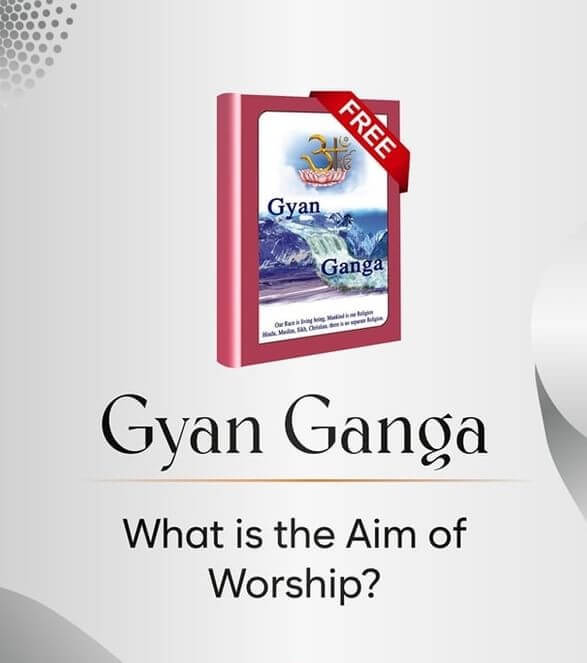Whom do Brahma, Vishnu and Shiv Worship
Help & Information / Whom do Brahma, Vishnu and Shiv Worship
Whom do Brahma, Vishnu and Shiv Worship
In Gyan Ganga, the profound spiritual text, insights are offered into the worship practices of Brahma, Vishnu, and Shiv—the trinity responsible for creation, preservation, and destruction within the material universe. While these gods are often perceived as the supreme deities, Gyan Ganga reveals that they, too, worship higher powers, specifically Kaal Brahm (also known as Jyoti Niranjan) and Durga (Prakriti), their parents.
The Roles of Brahma, Vishnu, and Shiv
Brahma, Vishnu, and Shiv, collectively known as the Tridev, have defined roles within the cosmos:
- Brahma (Rajogun) is responsible for creation.
- Vishnu (Satogun) sustains and preserves life.
- Shiv (Tamogun) performs the role of destruction and transformation.
These deities, however, are not eternal or all-powerful as commonly believed. According to Gyan Ganga, they were born from the union of Durga and Kaal Brahm, and are subject to the cycle of birth and death, just like other living beings. Therefore, they worship their creators—Durga and Kaal Brahm.
Whom Do Brahma, Vishnu, and Shiv Worship?
Brahma, Vishnu, and Shiv acknowledge that they owe their existence and power to Kaal Brahm and Durga, their parents. They worship these two deities, who are responsible for their birth and the material world's governance.
Kaal Brahm (also known as Brahm, or Jyoti Niranjan) is the father of Brahma, Vishnu, and Shiv. He rules over the twenty-one brahmands (material universes) and controls the cycle of life and death.
Durga (also called Prakriti or Ashtangi) is the mother of the trinity and the consort of Kaal Brahm. She is the embodiment of material energy (Prakriti) and is worshipped as the goddess of creation.
The Worship of Kaal Brahm and Durga
The text explains that while Brahma, Vishnu, and Shiv are powerful within the material realm, they are not independent or supreme. They perform their duties under the influence and direction of their parents, Kaal Brahm and Durga. This is why they worship these deities:
- Kaal Brahm Is Their Creator: As per Gyan Ganga and the scriptures it references, Brahma, Vishnu, and Shiv were born from Kaal Brahm’s union with Durga. Kaal Brahm, being their father, is worshipped by them as the ultimate authority over the material universe.
- Durga Is Their Mother: Durga, being the mother of the trinity, is revered by Brahma, Vishnu, and Shiv. She is the source of their existence, and they acknowledge her power by worshipping her as the goddess of creation.
- Kaal Brahm’s Dominion Over the Material World: Although Brahma, Vishnu, and Shiv are powerful gods within the material universe, they recognize that Kaal Brahm has control over life and death, and they cannot attain liberation from his domain. Therefore, they remain bound to the cycle of creation and destruction under his rule.
Scriptural Evidence of Their Worship
Gyan Ganga references several scriptures to demonstrate that Brahma, Vishnu, and Shiv worship their parents, Kaal Brahm and Durga. For instance, in the Shrimad Devi Bhagwat Puran, Vishnu himself acknowledges that Durga is his mother and that he, Brahma, and Shiv are all born from her. Similarly, in the Shiv Puran, Shiv admits that he, too, is subject to birth and death and worships Durga as his mother.
Additionally, Gyan Ganga explains that while Brahma, Vishnu, and Shiv govern the material universe, they worship Kaal Brahm for their positions of power. They know that Kaal Brahm controls the cycle of rebirth, and they cannot escape his influence without the intervention of a higher power—Supreme God.
Conclusion: Brahma, Vishnu, and Shiv Worship Kaal Brahm and Durga
According to Gyan Ganga, Brahma, Vishnu, and Shiv, despite their high standing in the cosmic hierarchy, worship their parents, Kaal Brahm and Durga. They understand that their authority is limited to the material realm, and they are subject to the cycles of birth, death, and rebirth. Kaal Brahm, as the ruler of the twenty-one brahmands, and Durga, as the mother goddess, are the deities they revere for their own existence and power.
In the broader context, Gyan Ganga teaches that true liberation cannot be attained through the worship of Brahma, Vishnu, Shiv, or their parents, Kaal Brahm and Durga, as they are all bound within the material universe. Instead, the text emphasizes the worship of Supreme God Kabir (KavirDev) as the path to complete salvation, transcending the material world and its limitations.
← Who is the Husband of Goddess Durga Is God in Form or Formless? →
